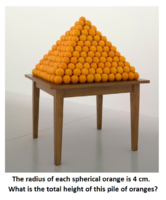You are using an out of date browser. It may not display this or other websites correctly.
You should upgrade or use an alternative browser.
You should upgrade or use an alternative browser.
Total height
- Thread starter Farzin
- Start date
- Joined
- Nov 24, 2012
- Messages
- 3,021
I would begin by finding the height \(h\) of a pyramid with a square base whose edges are all the same length \(s\).
[MATH]h^2+\left(\frac{s}{2}\right)^2=\left(\frac{\sqrt{3}}{2}s\right)^2[/MATH]
[MATH]h=\frac{s}{\sqrt{2}}[/MATH]
Now, with \(s=22r\) and accounting for the \(2r\) above and below, we have the height \(H\) of the pile of oranges:
[MATH]H=\frac{22r}{\sqrt{2}}+2r=(11\sqrt{2}+2)r[/MATH]
With [MATH]r=4\text{ cm}[/MATH] we find:
[MATH]H=(11\sqrt{2}+2)(4\text{ cm})\approx70.22539674441619\text{ cm}[/MATH]
[MATH]h^2+\left(\frac{s}{2}\right)^2=\left(\frac{\sqrt{3}}{2}s\right)^2[/MATH]
[MATH]h=\frac{s}{\sqrt{2}}[/MATH]
Now, with \(s=22r\) and accounting for the \(2r\) above and below, we have the height \(H\) of the pile of oranges:
[MATH]H=\frac{22r}{\sqrt{2}}+2r=(11\sqrt{2}+2)r[/MATH]
With [MATH]r=4\text{ cm}[/MATH] we find:
[MATH]H=(11\sqrt{2}+2)(4\text{ cm})\approx70.22539674441619\text{ cm}[/MATH]
Excellent. ??I would begin by finding the height \(h\) of a pyramid with a square base whose edges are all the same length \(s\).
[MATH]h^2+\left(\frac{s}{2}\right)^2=\left(\frac{\sqrt{3}}{2}s\right)^2[/MATH]
[MATH]h=\frac{s}{\sqrt{2}}[/MATH]
Now, with \(s=22r\) and accounting for the \(2r\) above and below, we have the height \(H\) of the pile of oranges:
[MATH]H=\frac{22r}{\sqrt{2}}+2r=(11\sqrt{2}+2)r[/MATH]
With [MATH]r=4\text{ cm}[/MATH] we find:
[MATH]H=(11\sqrt{2}+2)(4\text{ cm})\approx70.22539674441619\text{ cm}[/MATH]
Nice job, well done. ??I got 8+44√2

